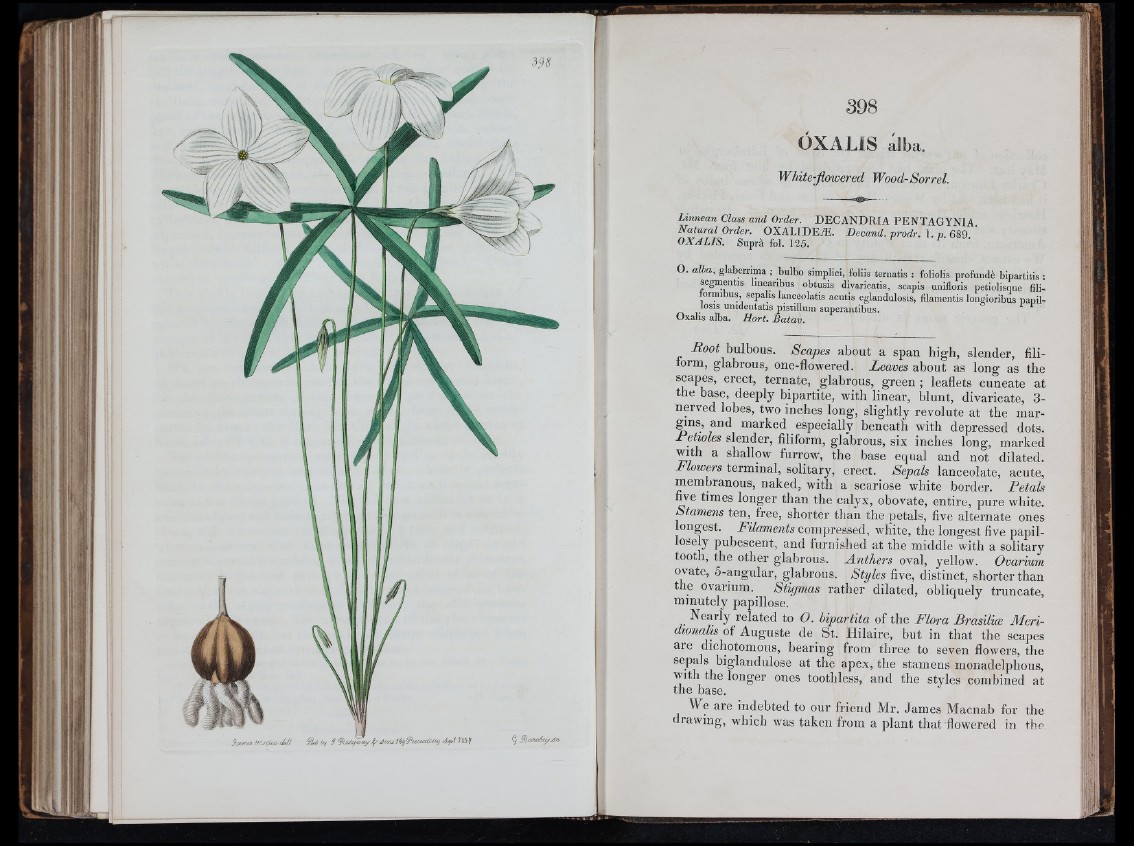
r i
I ;
/KJ/bUr d j/. 9 ^ù J yw a ^ ^A t/ru ìh ^9 ‘ico£c{U0f -àyA Ì83? 9 SiaivDcfy^ó
ÓXALIS alba.
White-flowered Wood-Sorrel.
Linnean Class and Order. DECANDRIA PENTAGYNIA
Natural Order. OXALIDExE. Decand. prodr. 1. ». 689
OXALIS. Suprà fol. 125.
O. alba, glaberrima ; bulbo simplici, foliis ternatis : foliolis profundè bipartitis :
segmentis linearibus obtusis divaricatis, scapis unifloris petiolisque fili-
tormibus, sepalis lanceolatis acutis eglandulosis, filamentis longioribus papil-
losis unidentatis pistillum superantibus.
Oxalis alba. Hort, Batav.
Root bulbous. Scapes about a span high, slender, fili-
lorm, glabrous, one-flowered. Leaves about as long as the
scapes, erect, ternate, glabrous, green ; leaflets cuneate at
the base, deeply bipartite, with linear, blunt, divaricate, 3-
nerved lobes, two inches long, slightly revolute at the margins,
and marked especially beneath with depressed dots.
Petioles slender, filiform, glabrous, six inches long, marked
^ t h a shallow furrow, the base equal and not dilated.
Blowers terminal, solitary, erect. Sepals lanceolate, acute,
membranous, naked, with a scariose white border. Petals
^ e times longer than the calyx, obovate, entire, pure white.
Stamens ten, free, shorter than the petals, five alternate ones
longest. Filaments compressed, white, the longest five papillosely
pubescent, and furnished at the middle with a solitary
tooth, the other glabrous. Anthers oval, yellow. Ovarium
ovate, 5-angular, glabrous. Styles five, distinct, shorter than
the ovarium. Stigmas rather dilated, obliquely truncate,
minutely papillose.
Nearly related to O. bipartita of the Flora Brasilia; Meri-
dionalis of Auguste de St. Hilaire, but in that the scapes
are dichotomous, bearing from three to seven flowers, the
s e p te biglandulose at the apex, the stamens monadelphous,
with the longer ones toothless, and the styles combined at
the base.
We are indebted to our friend Mr. James Macnab for the
drawing, which was taken from a plant that flowered in the